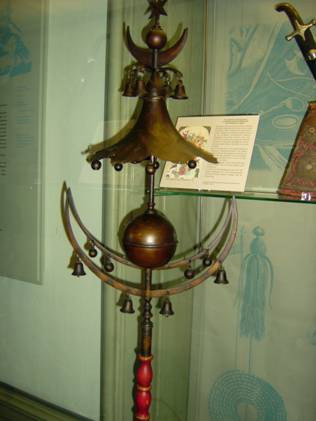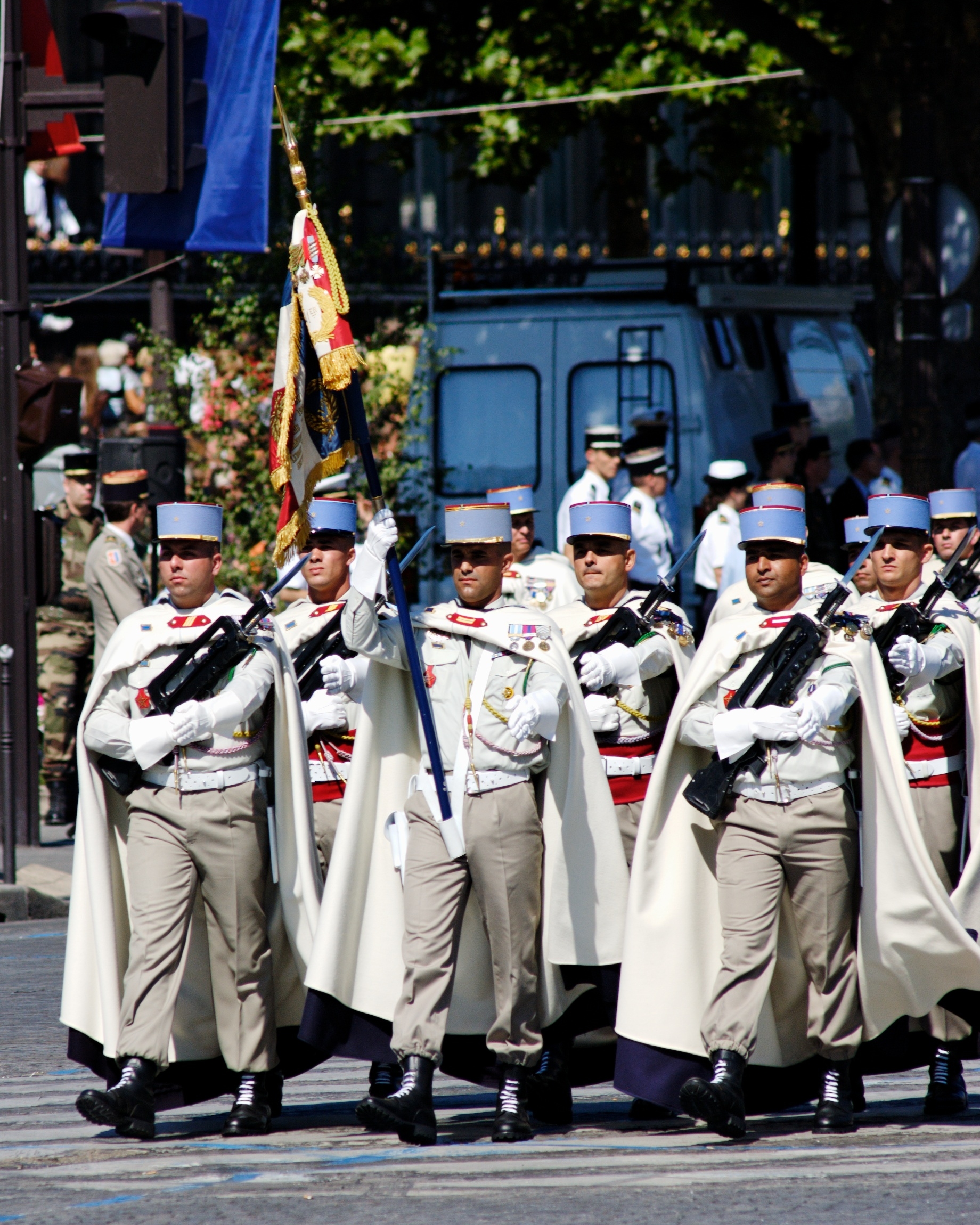|
Turkish Crescent
A Turkish crescent, (a smaller version is called a çevgen or ''çağana'' (Tr.), Turkish jingle, Jingling Johnny, ' (Ger.), ' or ''pavillon chinois'' (Fr.)), is a percussion instrument traditionally used by military bands internationally. In some contexts it also serves as a battle trophy or object of veneration. Description The instrument, usually long, consists of an upright wooden pole topped with a conical brass ornament and having crescent shaped crosspieces, also of brass. Numerous bells are attached to the crosspieces and elsewhere on the instrument. Often two horsetail plumes of different colors are suspended from one of the crescents; occasionally they are red-tipped, symbolic of the battlefield. There is no standard configuration for the instrument, and of the many preserved in museums, hardly two are alike. The instrument is held vertically and when played is either shaken up and down or twisted. Sometimes there is a geared crank mechanism for rotating it. Today the ... [...More Info...] [...Related Items...] OR: [Wikipedia] [Google] [Baidu] |
Java
Java (; id, Jawa, ; jv, ꦗꦮ; su, ) is one of the Greater Sunda Islands in Indonesia. It is bordered by the Indian Ocean to the south and the Java Sea to the north. With a population of 151.6 million people, Java is the world's List of islands by population, most populous island, home to approximately 56% of the Demographics of Indonesia, Indonesian population. Indonesia's capital city, Jakarta, is on Java's northwestern coast. Many of the best known events in Indonesian history took place on Java. It was the centre of powerful Hindu-Buddhist empires, the Islamic sultanates, and the core of the colonial Dutch East Indies. Java was also the center of the History of Indonesia, Indonesian struggle for independence during the 1930s and 1940s. Java dominates Indonesia politically, economically and culturally. Four of Indonesia's eight UNESCO world heritage sites are located in Java: Ujung Kulon National Park, Borobudur Temple, Prambanan Temple, and Sangiran Early Man Site. ... [...More Info...] [...Related Items...] OR: [Wikipedia] [Google] [Baidu] |
Glockenspiel
The glockenspiel ( or , : bells and : set) or bells is a percussion instrument consisting of pitched aluminum or steel bars arranged in a keyboard layout. This makes the glockenspiel a type of metallophone, similar to the vibraphone. The glockenspiel is played by striking the bars with mallets, often made of a hard material such as metal or plastic. Its clear, high-pitched tone is often heard in orchestras, wind ensembles, marching bands, and in popular music. Terminology In German, a carillon is also called a , and in French, the glockenspiel is sometimes called a . It may also be called a () in French, although this term may sometimes be specifically reserved for the keyboard glockenspiel. In Italian, the term () is used. The glockenspiel is sometimes erroneously referred to as a xylophone. The Pixiphone, a type of toy glockenspiel, was one such instrument sold as a xylophone. Range The glockenspiel is limited to the upper register and usually covers about to 3 octa ... [...More Info...] [...Related Items...] OR: [Wikipedia] [Google] [Baidu] |
Royal Hawaiian Band
The Royal Hawaiian Band is the oldest and only full-time municipal band in the United States. At present a body of the City & County of Honolulu, the Royal Hawaiian Band has been entertaining Honolulu residents and visitors since its inception in 1836 by Kamehameha III. During the monarchy it was nominally a military band. It reached global prominence under the leadership of Prussian Heinrich "Henri" Berger, an officer of the imperial German army loaned to the Kingdom of Hawaii in 1872. Berger composed many beloved marching tunes and other melodies, and would later be honored with the title of "Father of Hawaiian Music." He collaborated with King Kalākaua in creating '' Hawaii Ponoi,'' the national anthem of Hawaii; it is still used today as the official state song. During its long and distinguished history, the Royal Hawaiian band inspired the development of other brass bands in Hawaii, and possibly elsewhere in Polynesia and the Pacific. According to researcher Patrick Henn ... [...More Info...] [...Related Items...] OR: [Wikipedia] [Google] [Baidu] |
Kalākaua
Kalākaua (David Laʻamea Kamananakapu Mahinulani Naloiaehuokalani Lumialani Kalākaua; November 16, 1836 – January 20, 1891), sometimes called The Merrie Monarch, was the last king and penultimate monarch of the Hawaiian Kingdom, Kingdom of Hawaiʻi, reigning from February 12, 1874, until his death in 1891. Succeeding Lunalilo, he was elective monarchy, elected to the vacant throne of Hawaiʻi against Queen Emma of Hawaii, Queen Emma. Kalākaua had a convivial personality and enjoyed entertaining guests with his singing and ukulele playing. At his coronation and his birthday jubilee, the hula, which had hitherto been banned in public in the kingdom, became a celebration of Hawaiian culture. During Kalākaua's reign, the Reciprocity Treaty of 1875 brought great prosperity to the kingdom. Its renewal continued the prosperity but allowed United States to have exclusive use of Pearl Harbor. In 1881, Kalākaua took a trip around the world to encourage the immigration ... [...More Info...] [...Related Items...] OR: [Wikipedia] [Google] [Baidu] |
William I, German Emperor
William I or Wilhelm I (german: Wilhelm Friedrich Ludwig; 22 March 1797 – 9 March 1888) was King of Prussia from 2 January 1861 and German Emperor from 18 January 1871 until his death in 1888. A member of the House of Hohenzollern, he was the first head of state of a united Germany. He was de facto head of state of Prussia from 1858, when he became regent for his brother Frederick William IV, whose death three years later would make him king. Under the leadership of William and his minister president Otto von Bismarck, Prussia achieved the unification of Germany and the establishment of the German Empire. Despite his long support of Bismarck as Minister President, William held strong reservations about some of Bismarck's more reactionary policies, including his anti-Catholicism and tough handling of subordinates. In contrast to the domineering Bismarck, William was described as polite, gentlemanly and, while staunchly conservative, more open to certain classical liberal ideas th ... [...More Info...] [...Related Items...] OR: [Wikipedia] [Google] [Baidu] |
Brazilian Marine Pipes, Drum And Bugle Corps
The Brazilian Marine Pipes, Drum and Bugle Corps (''Banda Marcial dos Fuzileiros Navais'') is the only field music (corps of drums, drum and bugle corps and pipe band) formation in service in the Brazilian Marine Corps and within the wider Brazilian Navy, and one of a few active formations today in service in the Brazilian Armed Forces. Formed in 1822 on the basis of the field music formations of the present day Portuguese Marine Corps stationed in Brazil (when it was part of the United Kingdom of Portugal, Brazil and the Algarves and then as part of the Royal Brigade of the Navy (''Brigada Real da Marinha'') stationed in the colony), it is also the oldest in South America. Brief history and present day role The BMPDC, as a component of the Marine Corps and the Navy, has been the primary field music formation of the corps since independence, and plays alongside the Central Band of the Brazilian Marine Corps in all ceremonies of national importance. Its first appearance in Indep ... [...More Info...] [...Related Items...] OR: [Wikipedia] [Google] [Baidu] |
Spahi
Spahis () were light-cavalry regiments of the French army recruited primarily from the indigenous populations of Algeria, Tunisia and Morocco. The modern French Army retains one regiment of Spahis as an armoured unit, with personnel now recruited in mainland France. Senegal also maintains a mounted unit with spahi origins as a presidential escort: the Red Guard. Etymology The name is the French form of the Ottoman Turkish word , a word derived from New Persian , meaning "army", or "horsemen"; or from , meaning "warriors". Early history Following the French occupation of Algiers in 1830, detachments of locally recruited irregular horsemen were attached to the regiments of light cavalry assigned to North African service. These auxiliaries were designated as ''chasseurs spahis''. Between 1834 and 1836 they were organised into four squadrons of regular spahis. In 1841 the 14 squadrons by then in existence were brought together in a single corps of spahis. Finally, in 1845 t ... [...More Info...] [...Related Items...] OR: [Wikipedia] [Google] [Baidu] |
Janissary
A Janissary ( ota, یڭیچری, yeŋiçeri, , ) was a member of the elite infantry units that formed the Ottoman Sultan's household troops and the first modern standing army in Europe. The corps was most likely established under sultan Orhan (1324–1362), during the Viziership of Alaeddin. Janissaries began as elite corps made up through the devşirme system of child levy, by which Christian Albanians, Romanians, Armenians, Bulgarians, Croats, Greeks and Serbs were taken, levied, subjected to circumcision and conversion to Islam, and incorporated into the Ottoman army. They became famed for internal cohesion cemented by strict discipline and order. Unlike typical slaves, they were paid regular salaries. Forbidden to marry before the age of 40 or engage in trade, their complete loyalty to the Sultan was expected. By the seventeenth century, due to a dramatic increase in the size of the Ottoman standing army, the corps' initially strict recruitment policy was relaxed. Civili ... [...More Info...] [...Related Items...] OR: [Wikipedia] [Google] [Baidu] |

.jpg)

.jpg)

